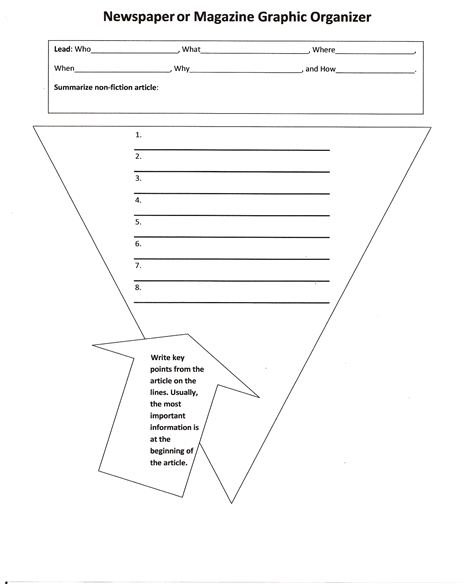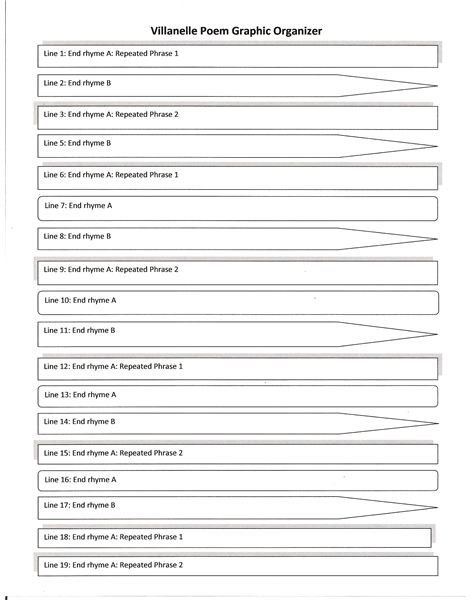An Overview of the Types of Graphic Organizers for Teachers
Styles and Types
There are many types of graphic organizers to help students learn. Graphic organizers can arrange content, organize writing ideas, categorize reading material, help students learn vocabulary, etc. There are free graphic organize that anyone can print.
Organizing Graphic Organizers
Because there are so many types of graphic organizers, it is helpful to know how to use them in the classroom. The graphic organizers can easily be organized by purpose:
- Reading graphic organizers
- Vocabulary graphic organizers
- Content graphic organizers
- Writing graphic organizers
**
Reading Graphic Organizers
Reading graphic organizers help students to understand a non-fiction piece, story, novel, poem or play better. The organizers also can help students to understand the parts of the plot and types of literary elements used. In addition, students can use graphic organizers to learn characters, setting, etc.
A plot graphic organizer will help students to identify the exposition, conflicts, rising action, climax, falling action and resolution. Mostly with reading graphic organizers, students can identify the sequence of events, such as the beginning, ending and end in novels.
Non-fiction Reading: Newspaper or Magazine Graphic Organizers
Sometimes, students will struggle with non-fiction on the state achievement tests, and a graphic organizer can help the student to learn how the information is organized. If students are struggling to understand nonfiction pieces, such as newspaper articles, magazine articles or journal articles, teachers can help them by having students fill out the graphic organizer that is included with this article.
On the Newspaper or Magazine Graphic Organizer, students should write down the key components of the lead in the first box. It is usually the first sentence, but it is generally in the first two paragraphs. A lead tells who, what, where, when, why and how. The lead tells what the article will discuss. In addition, students should summarize the article.
The information in the rest of the article is usually arranged in the inverted pyramid style of news writing. The most important information is at the top and the least important information is at the bottom. On the graphic organizer include, students can write down eight main points from the article in the lines on the inverted pyramid.
Vocabulary Graphic Organizers
Vocabulary graphic organizers can help students to study vocabulary words or deepen their understanding of a word. The various graphic organizers can help students to expand their vocabulary.
Content Graphic Organizers
Content graphic organizers help students to learn content from textbooks or other sources. These graphic organizers help students organize their information into “chunks” or sections that are easier to study or to learn. Also, the graphic organizers can show connections between information and help students summarize information.
Newspaper or Magazine Graphic Organizer

Types of Writing Graphic Organizers: Villanelle Poem Graphic Organizer
The last type of graphic organizer is the writing graphic organizer. When students need to write, they need to brainstorm ideas and then organize the information. Using a writing graphic organizer helps students to not stare at a blank piece of paper for hours on end.
Writing graphic organizers can help students to write essays, stories, memoirs, plays, and poems. There are many types of poems. One complex poem that students can write is called a Villanelle.
Villanelle Poem Graphic Organizer
The Villanelle Poem Graphic Organizer can help students to write a 19 line poem. It has five tersest and one quatrain. One of the most famous villanelle poems is Do Not Go Gentle into That Good Night by Dylan Thomas_._ However, villanelles can be lighthearted and fun to write too. For example, the Richard Henry Lee Elementary School Poetry blog spot showcases some villanelles for young readers.
For students to write a villanelle poem, they must follow a specific rhyme pattern and repeat certain lines. It can be fun but also somewhat frustrating. The Villanelle Poem Graphic Organizer shows the student what type of rhyme needs to go on each line. The lines that should have similar rhyme patterns have similar shapes.
End Rhyme Pattern
The end rhyme pattern refers to the rhyme pattern at the end of poem lines. For example in the following example, the rhyme pattern is ABAB. The last word of each line rhymes with every other line.
Dogs run and prance A
Sniffing, digging, wagging B
Cats claw at any chance A
Pouncing, sleeping, purring B
The villanelle has two end rhymes A and B throughout the poem, but is very complex. If students follow the graphic organizer, they should write a villanelle with no problem.
The writing graphic organizer can help students write many types of writing assignments. The trick is finding the right one for the assignment. On Brighthub.com many examples are available.
Villanelle Poem Graphic Organizer

This post is part of the series: Graphic Organizers
The articles in this series will explain and give ideas on how to use graphic organizers.
